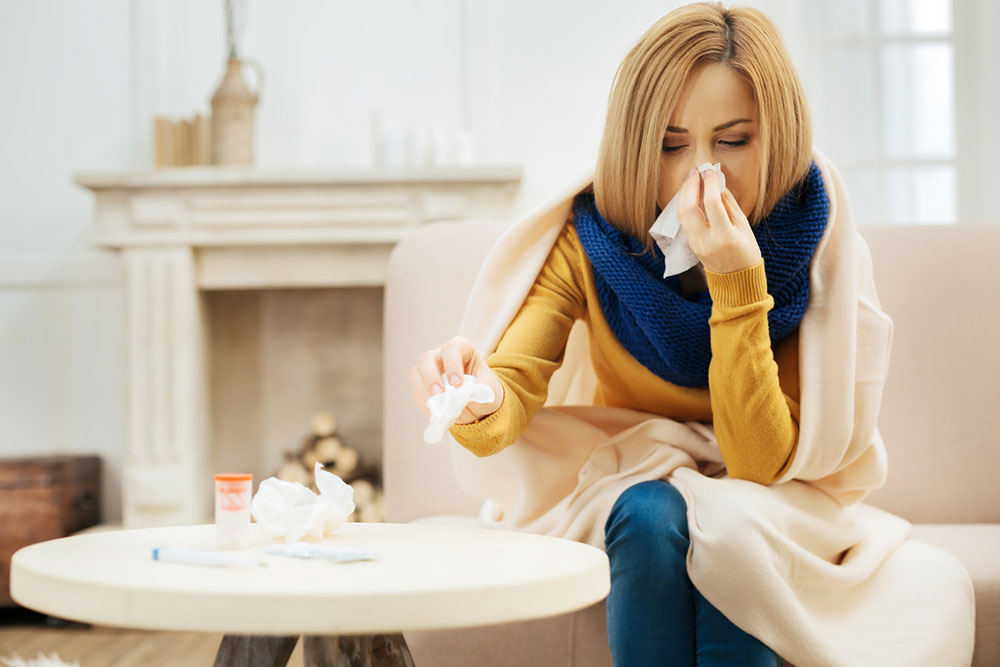10 ways that may help stop a runny nose

Experiencing a runny nose, also known as rhinorrhea, can be a frustrating symptom caused by viral infections, sinusitis, allergies, and sometimes cold weather. This symptom can be accompanied by nasal congestion, leading to much discomfort. Although rhinorrhea typically subsides on its own, it can be pretty bothersome. Fortunately, there are several ways one can try to alleviate this annoying symptom and put a stop to a runny nose. Some of them are:
Take steam
Inhaling steam is a simple yet effective method to relieve a runny nose. It helps by loosening mucus, clearing nasal passages, and alleviating discomfort associated with a runny nose. A helpful way to inhale steam is by slightly heating some water in a clean vessel – like a pot or a bowl, leaning over the vessel, covering oneself with a towel or blanket, and inhaling the steam. However, one would need to take care of a few factors when trying this method, such as only heating the water till it starts steaming and not letting it boil, keeping their face at a safe distance from the bowl (about 10 inches away), and closing their eyes when inhaling the steam. One can also enhance the steam’s effectiveness by adding a few drops of essential oils like eucalyptus or peppermint, which have decongestant properties.
Apply a warm compress
Another simple method to help relieve a runny nose is applying a warm compress over the nose and the forehead. For this, one must soak a clean cloth in warm water and place it over their nose and forehead. The warmth will soothe the nasal passages and relieve the symptoms. However, when trying this method, it is crucial to ensure the compress’ temperature is not too hot to avoid burning the skin.
Stay hydrated
Drinking plenty of water and other hydrating fluids is necessary when dealing with a runny nose. Staying hydrated helps keep mucus thin and is easier to expel. While drinking water is the best way to stay hydrated, at times of nasal congestion and runny nose, one can also consume other fluids such as clear broth, herbal teas, and warm lemon water. These warm fluids help provide relief to other accompanying symptoms, such as nasal congestion and a sore throat, as well. While it is advisable to consume these fluids, it is also necessary to avoid other fluids, such as coffee, as they can cause dehydration.
Eat foods that contain capsaicin
Eating spicy foods is a unique but practical approach to relieving a runny nose and nasal congestion. Spices and ingredients, such as chili peppers, contain capsaicin, which can release heat into the body and help loosen mucus. This then makes it easier to expel mucus, thereby helping relieve nasal congestion. However, when consuming spicy foods, it’s essential not to overindulge, as excessive intake can also lead to discomfort. Hence, one can add spices to their meals per their tolerance levels.
Use neti pots
Neti pots are small teapot-shaped vessels that can help relieve nasal congestion and a runny nose by aiding in nasal irrigation. To use, fill the neti pot with a warm saline solution and pour it from the pot’s spout into one nostril, allowing it to flow out the other. The saltwater solution helps flush out irritants, allergens, and excess mucus from the nasal passages, providing a soothing and immediate remedy for a runny nose. However, it’s crucial to use distilled or sterilized water to prevent the risk of infections when trying this method.
Consume hot tea
Hot teas, especially herbal varieties like chamomile, mint, or ginger, can be a soothing and effective way to alleviate a runny nose. These herbs have natural decongestant properties, which can help clear a stuffy nose and relieve nasal symptoms. Moreover, herbs like chamomile and ginger also have anti-inflammatory properties that can help reduce inflammation in the nasal passages. This method is incredibly helpful if one is experiencing a sore throat as well. One can even add a spoonful of honey to the warm tea for its cough-suppressing qualities and as a natural sweetener.
Take a hot shower
Taking a hot shower or a hot bath is also a simple and effective way to relieve a runny nose and nasal congestion. The steam from the shower or the bath creates a warm environment that can help clear nasal passages and ease congestion.
Use a humidifier
Using a humidifier in the room works like taking a hot shower or inhaling warm steam. Humidifiers add warm steam and moisture to the air, which prevents one’s nasal passages from drying out and becoming irritated. Moist air also helps in effectively reducing the thickness of mucus, thus making it easier to expel. However, when using a humidifier, it is crucial to keep it clean to prevent the growth of mold or bacteria in its water.
Use a nasal spray
Instead of using neti pots for flushing the nasal passage with a saline solution, one can also use saline nasal sprays. These sprays work by clearing nasal passages with saltwater. They effectively help in thinning mucus and reducing congestion. However, it’s essential to be mindful when using these sprays. One must avoid using decongestant nasal sprays for an extended period and follow the guidelines mentioned in the package.
Get sufficient rest
When dealing with a runny nose, nasal congestion, or similar discomforting symptoms, it is essential to take an adequate amount of rest. Resting allows the body to focus on healing and recovering. One must ensure getting enough sleep and not doing physical activity to allow the immune system to focus on combating the underlying causes. In addition to promoting a faster recovery, getting sufficient rest helps alleviate fatigue that may have accompanied the other symptoms.

